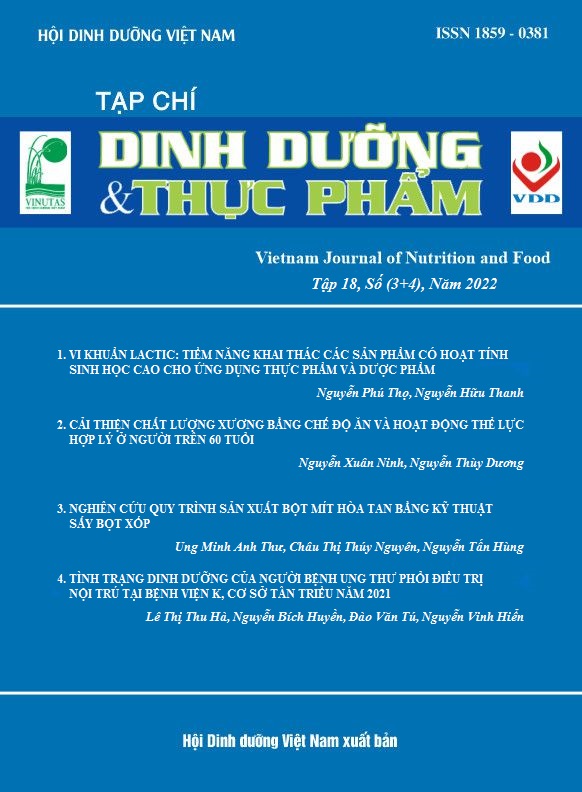NGHIÊN CỨU QUY TRÌNH SẢN XUẤT BỘT HÒA TAN TỪ MÍT THÁI BẰNG KỸ THUẬT SẤY BỌT XỐP
Nội dung chính của bài viết
Tóm tắt
Mục tiêu: Xác định các thông số thích hợp cho quy trình sản xuất sản phẩm bột hòa tan từ nguyên liệu mít Thái (Changai) thứ phẩm bằng kỹ thuật sấy bọt xốp.
Phương pháp: Nghiên cứu được thực hiện trên cơ sở khảo sát (i) các yếu tố ảnh hưởng đến quá trình tạo bọt (tỉ lệ bổ sung albumin trứng và Carboxylmetyl Cellulose) và (ii) ảnh hưởng của điều kiện sấy bằng không khí nóng (nhiệt độ sấy và độ dày màng bọt) đến chất lượng bột mít hòa tan.
Kết quả: Dịch mít được tiến hành tạo bọt với albumin trứng (4%) và CMC (7,5%) giúp tạo được màng bọt tốt và bền vững. Mặt khác, màng bọt xốp được tiến hành sấy ở nhiệt độ 60oC và độ dày 3 mm giúp thu hồi bột có màu sắc tốt và hàm lượng chất dinh dưỡng được lưu giữ tốt nhất hàm lượng vitamin C 3,96 mg%; hàm lượng carotenoid là 5,34 mg/g; hàm lượng đường tổng 11,27%, đường khử 8,33 g/100g, hàm lượng acid toàn phần 0,077% và độ ẩm thấp 4,28%.
Kết luận: Kết quả nghiên cứu này giúp đa dạng hóa các sản phẩm từ mít bằng phương pháp sấy mới giúp tiết kiệm chi phí nhưng vẫn giữ được chất lượng.
Từ khóa
Albumin, CMC, carotenoid, mít Thái non, muối chua, chất lượng, nồng độ giấm, sấy màng lọc, vitamin C
Chi tiết bài viết
Tài liệu tham khảo
2. An, V. N., Thinh, P. Van, Do, V. L., Duy, N. Q., Thuy, D. T., & Hien, T. T. (2022). The Influencing Factors on the Production of Alcoholic Drinking from Jackfruit (Artocarpus heterophyllus L.). Materials Science Forum, 1048 MSF(October), 476–484.
3. Kumoro, A. C., Sari, D. R., Pinandita, A. P. P., Retnowati, D. S., & Budiyati, C. S. (2012). Preparation of wine from jackfruit (Artocarpus heterophyllus lam) Juice using baker yeast: Effect of yeast and initial sugar concentrations. World Applied Sciences Journal, 16(9), 1262–1268.
4. Marak, N. R., Nganthoibi, R. K., & Momin, C. W. (2019). Process Development for Brining of Tender Jackfruit. International Journal of Current Microbiology and Applied Sciences, 8(04), 2408–2414.
5. Phisut, N. (2012). Spray drying technique of fruit juice powder:some factors influencing the properties of product. International Food Research Journal, 19(4), 1297–1306.
6. G. Pandidurai and P. Vennila. (2018). Studies on Development of Fruit Powder from Muskmelon ( Cucumis Melo L .) by Using Spray Drier. Madras Agric. J., 105 (4-6): 215-219.
7. Salahi, M. R., Mohebbi, M., & Taghizadeh, M. (2017). Development of cantaloupe (Cucumis melo) pulp powder using foam-mat drying method: Effects of drying conditions on microstructural of mat and physicochemical properties of powder. Drying Technology, 35(15), 1897–1908.
8. Wang, Y., T. D. Wig, J. Tang, and L. M. Hallberg. 2003. Dielectric properties of foods relevant to RF and microwave pasteurization and sterilization. Journal of Food Engineering, 57:257–268.
9. Quek, S. Y., Chok, N. K., & Swedlund, P. (2007). The physicochemical properties of spray-dried watermelon powders. Chemical Engineering and Processing: Process Intensification, 46(5), 386–392.
10. Khamjae, T., & Rojanakorn, T. (2018). Foam-mat drying of passion fruit aril. International Food Research Journal, 25(1), 204–212.
11. Macedo, L. L., Corrêa, J. L. G., Araújo, C. da S., Vimercati, W. C., & Pio, L. A. S. (2021). Process optimization and ethanol use for obtaining white and red dragon fruit powder by foam mat drying. Journal of Food Science, 86(2), 426–433.
12. Azizpour, M., Mohebbi, M., & Khodaparast, M. H. H. (2016). Effects of foam-mat drying temperature on physico-chemical and microstructural properties of shrimp powder. Innovative Food Science and Emerging Technologies, 34, 122–126.
13. Franco, T. S., Perussello, C. A., Ellendersen, L. N., & Masson, M. L. (2016). Effects of foam mat drying on physicochemical and microstructural properties of yacon juice powder. LWT - Food Science and Technology, 66, 503–513.
14. Ozkan, I. A., Akbudak, B., & Akbudak, N. (2007). Microwave drying characteristics of spinach. Journal of Food Engineering, 78(2), 577–583.
15. Zheng, X.-Z., Liu, C.-H., & Zhou, H. (2011). Optimization of Parameters for Microwave-Assisted Foam Mat Drying of Blackcurrant Pulp. Drying Technology, 29(2), 230–238.
16. Kadam, D. M., Wilson, R. A., Kaur, S., & Manisha. (2012). Influence of foam mat drying on quality of tomato powder. International Journal of Food Properties, 15(1), 211–220.
17. Rajkumar, P., Kailappan, R., Viswanathan, R., Raghavan, G. S. V., & Ratti, C. (2007). Foam mat drying of Alphonso mango pulp. Drying Technology, 25(2), 357–365.
18. Muratore, G., Rizzo, V., Licciardello, F., and Maccarone, E. (2008). Partial dehydration of cherry tomato at different temperatures and nutritional quality of the products. Food Chemistry 111: 887-891.
Các bài báo tương tự
- Hà Thùy Linh, Nguyễn Mạnh Đạt, Nguyễn Thị Minh Tú, NGHIÊN CỨU ỨNG DỤNG ĐƯỜNG TREHALOSE TRONG LÊN MEN SỮA CHUA , Tạp chí Dinh dưỡng và Thực phẩm: Tập 16 Số 2 (2020)
Ông/Bà cũng có thể bắt đầu một tìm kiếm tương tự nâng cao cho bài báo này.


